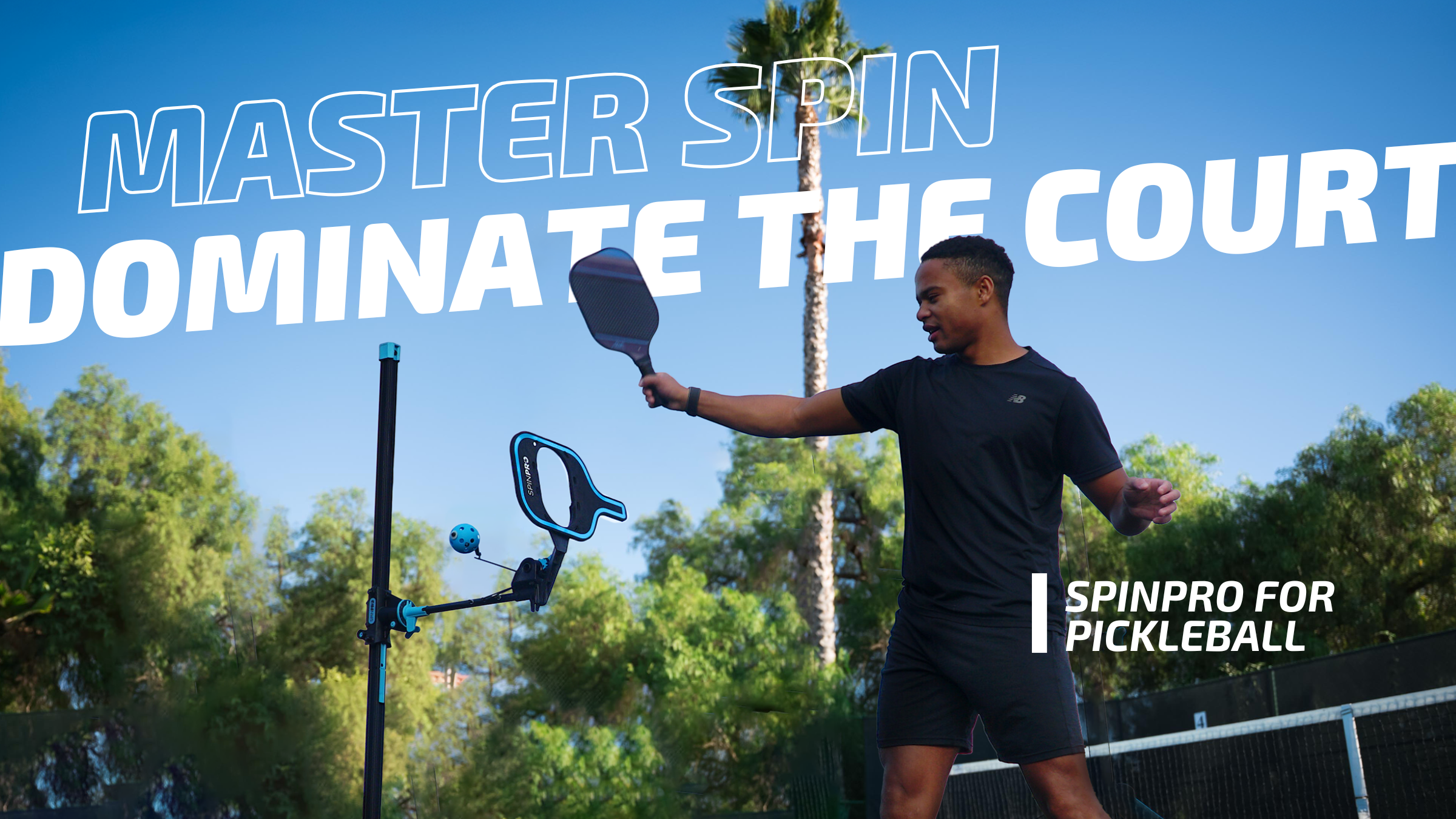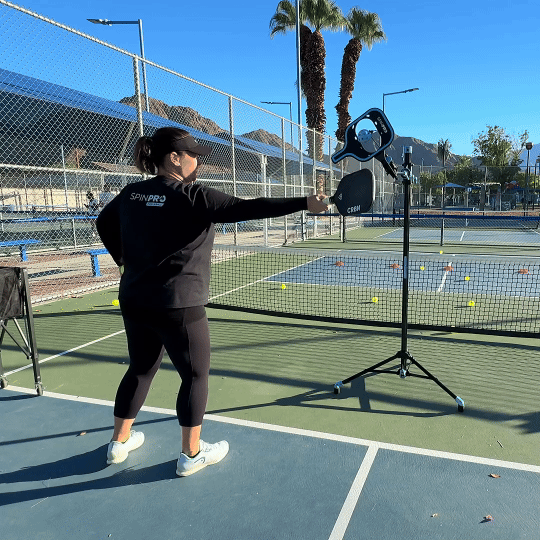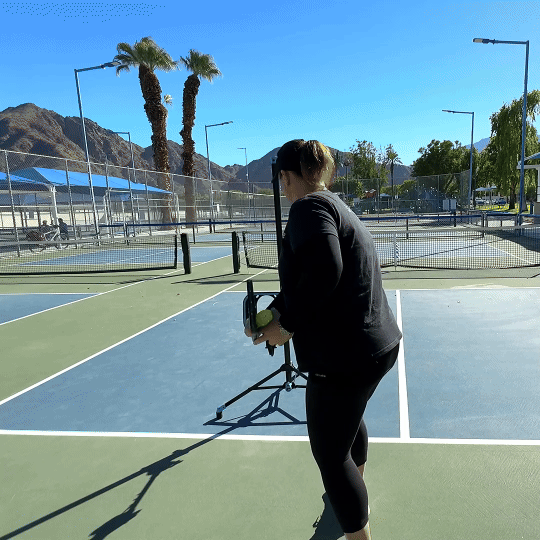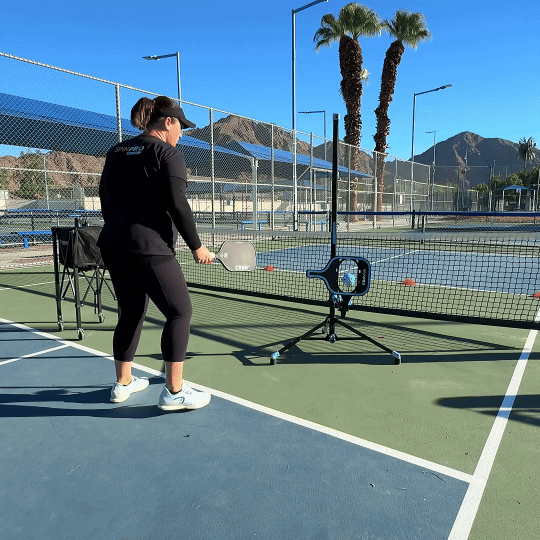
Executing a topspin shot begins with knowing when to hit it.
But first, let’s define topspin: it’s generated by brushing upward on the back of the ball, making it spin forward and jump up after it bounces. This forward spin also causes the ball to dip sooner, allowing you to hit harder without sending it out of bounds.
Topspin is the opposite of slice, which creates backspin that keeps the ball low after bouncing—or, in extreme cases, makes it spin backward.

Topspin is the more useful spin in pickleball because it spins into your opponent, which pushes them backward.
As we all know, pickleball is like a tug of war: if you can keep your opponents on their back foot or in the back of the court, you have a higher percentage chance of winning the point.
1. When Should You Use Topspin?
So when should you hit topspin?
If you are comfortable hitting it, you should hit it as often as possible, including serves, dinks, third-shot drops and drives and fourth-shot volleys.
Here’s a good rule of thumb: if your opponent’s shot does not put you in a defensive position, topspin is an option.
When in doubt, go with a non-topspin safer shot that you know you can execute.
Example:
You hit a serve and your opponent hits a hard return that bounces close to the baseline, that might not be the best time to try to hit a topspin third-shot drop landing in the kitchen. Instead, take the pace your opponent has given you and hit a defensive flat third-shot drop, ensuring that you get a chance at playing another ball. Going for a topspin shot in that scenario has a higher percentage of resulting in an error.
Know your topspin ability and use it situationally until you are comfortable enough to use it on the majority of your shots.
2. Limit your Backswing, and Follow Through
I see so many amateurs trying to learn how to hit topspin by using way too much wrist, resulting in too much spin and zero control.
I describe the motion of hitting topspin as gently waving at the ball with your palm facing down, or using a hand signal to tell your waiter you can’t possibly eat more food. Hitting topspin is not opening your wrist and closing it with an extreme amount of wrist. It’s a much more subtle movement.
Additionally, you shouldn’t be brushing up the back of the ball too much. You are not hitting a Rafael Nadal forehand.
Apply a slight brush up the back of the ball, and make sure you follow through the ball just as much as you are brushing.
Whether you are hitting a drop from the baseline or a dink from the Kitchen, a subtle combination of brushing up the back of the ball and following through the ball is what makes a great topspin shot.
One thing remains constant no matter what shot you are hitting (topspin volley pinning your opponents back, third-shot topspin drop, topspin serve, etc.): do not take a big backswing.
Leave the huge backswings to the pros, who have such good timing they can get away with it. A huge backswing leads to too many timing and mechanical issues. Keep it short and sweet and use your core and legs as your power sources.
Remember that hitting hard in pickleball is overrated, especially from deep in the court. Shorten your backswing, brush up the back of the ball while hitting through it, and utilize topspin to make your way to the Kitchen where you want to get the ball down to your opponents’ feet, setting yourself up for a finishing shot.
3. Start Slow & Build Up Topspin
While you shouldn’t emulate professional pickleball players’ backswings, you should absolutely emulate their decision-making and shot variety. While advanced paddle technology has resulted in more topspin in the professional game, the pros still use a variety of spin (or no-spin) shots in every point.
As an amateur, it’s important to build variety in your game. This will make you much tougher to beat and help you exploit your opponents’ weaknesses. To be a true chameleon, you need to be able to hit the occasional slice or flat shot in addition to using topspin to pin your opponents back.
In-Game Scenarios to Work On:
Topspin Fourth Shot Volleys:
After returning the serve and running to the net, practice using topspin on your fourth shot volley to keep your opponents pinned back. Hitting slice or even flat in this scenario can lead to shorter shots, inviting your opponents to come forward.
Keep your court positioning advantage, and use topspin to hit a good deep shot to pin your opponents back and making them execute drops on the fifth or even seventh shot.

Topspin Drops and Drives:
Next, work on adding topspin to your third shot drops and drives.
This will be a bit more difficult than using topspin on the fourth shot volley, but you still will have some room for error since you will be further back in the court and able to scramble for the next shot.
Remember to limit your backswing, and above all, make sure you clear the net to stay in the point.

Topspin Dinks:
This is by far the hardest shot to consistently hit topspin on, since it requires the most amount of control and you have almost no room for error.
If you aren’t comfortable hitting topspin, using it on dinks can result in a lot of errors in the net or pop-ups that are easy for your opponents to smash.
Work through the two shots above to build your comfortability hitting topspin before attempting to master the topspin dink.

Using SpinPro to Learn Spin
One of the best ways to master the art of spin is to build muscle memory. Training tools like the SpinPro Pickleball Trainer can help you accelerate that learning curve by mimicking the spin shot without needing to collect a hundred balls.
A key technology built into the SpinPro is the screen that forces you to hit the balls at the correct angles to generate the most spin and slice. For learning topspin, the screen forces your paddle to stay within a 75-80 degree angle which is the optimum angle for generating topspin.
Brandon Wortkotter, known as @bw_pickleball on Instagram, has experienced firsthand how transformative the SpinPro can be: "This training tool does everything. It allows you to work on generating slice and topspin from varying heights and positions. Now you're able to practice literally every shot in different scenarios from the comfort of your home."
Thanks for reading, and be on the lookout for the next article. Enjoy the grind, and remember, you can’t dink all day if you don’t start in the morning.

Eric Roddy
Eric is a PPA tour pro living in Charlotte, NC, sponsored by PROXR. In addition to playing PPA events, he teaches pickleball 2-3 hours a week, enjoys golf, and listening to his favorite band Goose.
Love Pickleball? Join 100k+ readers for free weekly tips, news & gear deals.
Subscribe to The DinkGet 15% off pickleball gear at Midwest Raquet Sports






